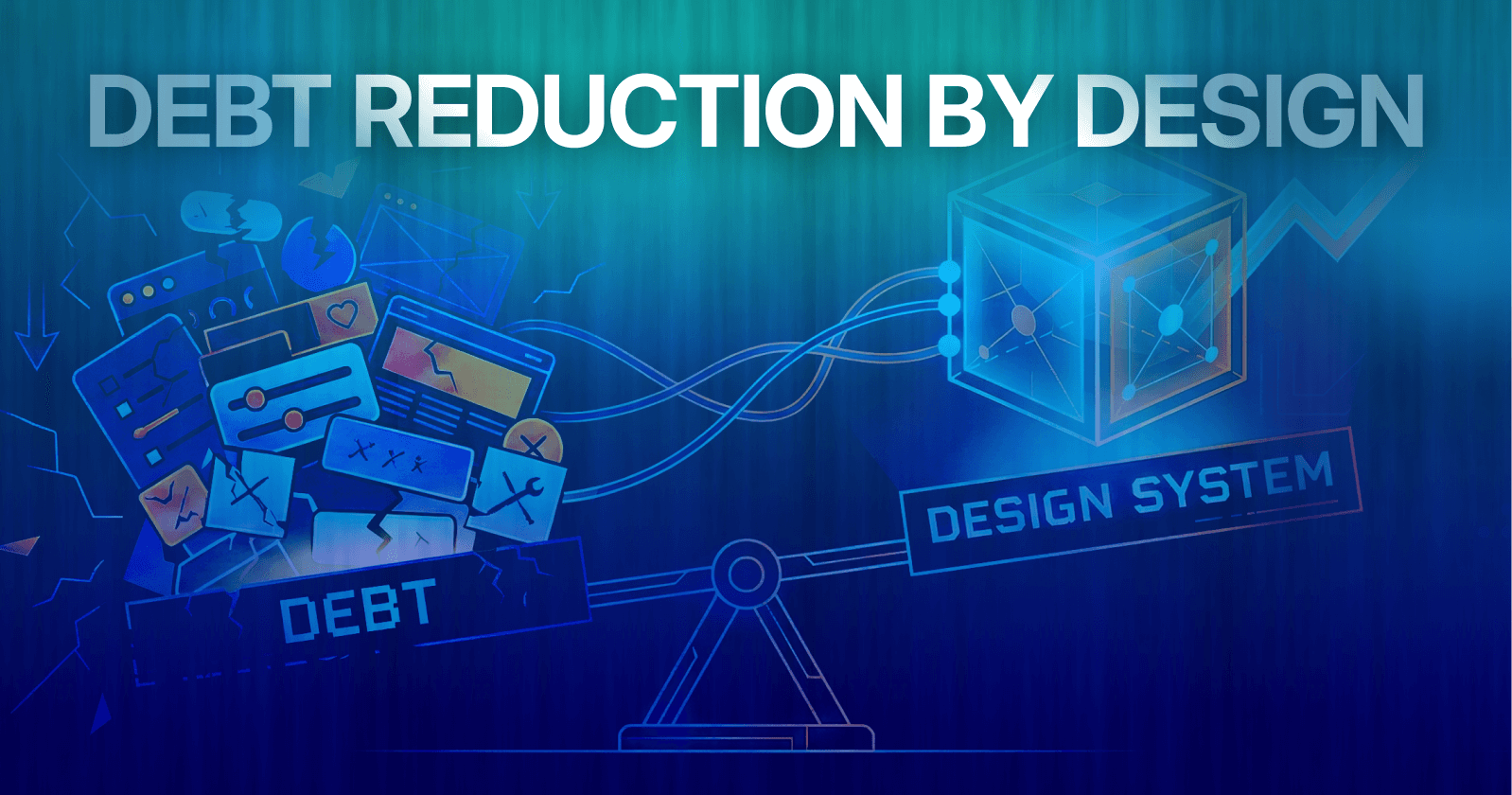Last Update:
Nov 6, 2025
Share
Groove cut churn by 71% using predictive alerts and automation.
Slack reduced trial churn 30% by boosting team collaboration.
Dropbox lowered churn through role-based training and education.
Amplitude improved retention with guided in-product onboarding.
Zapier dropped churn to 6–10% using milestone-based onboarding.
Heyday cut early churn 300% with a 3-step setup and fast activation.
StatusPage.io saved $1.2M ARR with automated re-engagement.
SmartReach.io reduced churn 35% via health scores and alerts.
Winning teams tracked behavior, automated responses, and optimized early user experience.
Education, segmentation, and collaboration fueled lasting retention.
Churn is the silent killer of SaaS businesses. You can pour money into acquiring customers, but if they're leaking out the back door, you're running on a treadmill to nowhere. The good news? Some brilliant Y Combinator-backed companies have cracked the code on retention—reducing churn by 30-75% and we're going to break down their playbooks in detail.
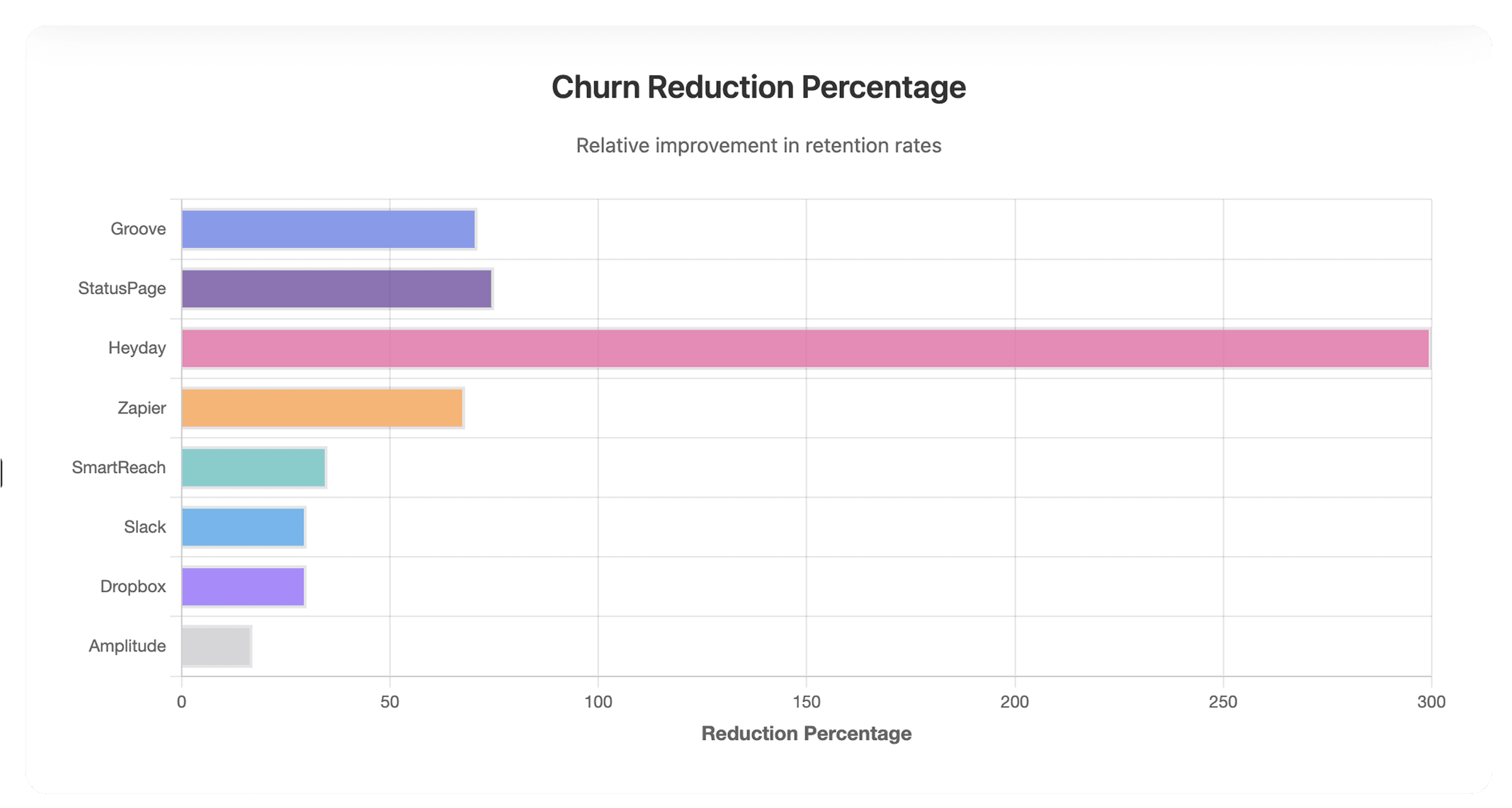
We've studied eight SaaS startups that transformed their retention rates, and in this deep dive, we'll show you exactly how they identified their churn problems, diagnosed the root causes, built systematic solutions, and achieved dramatic results.
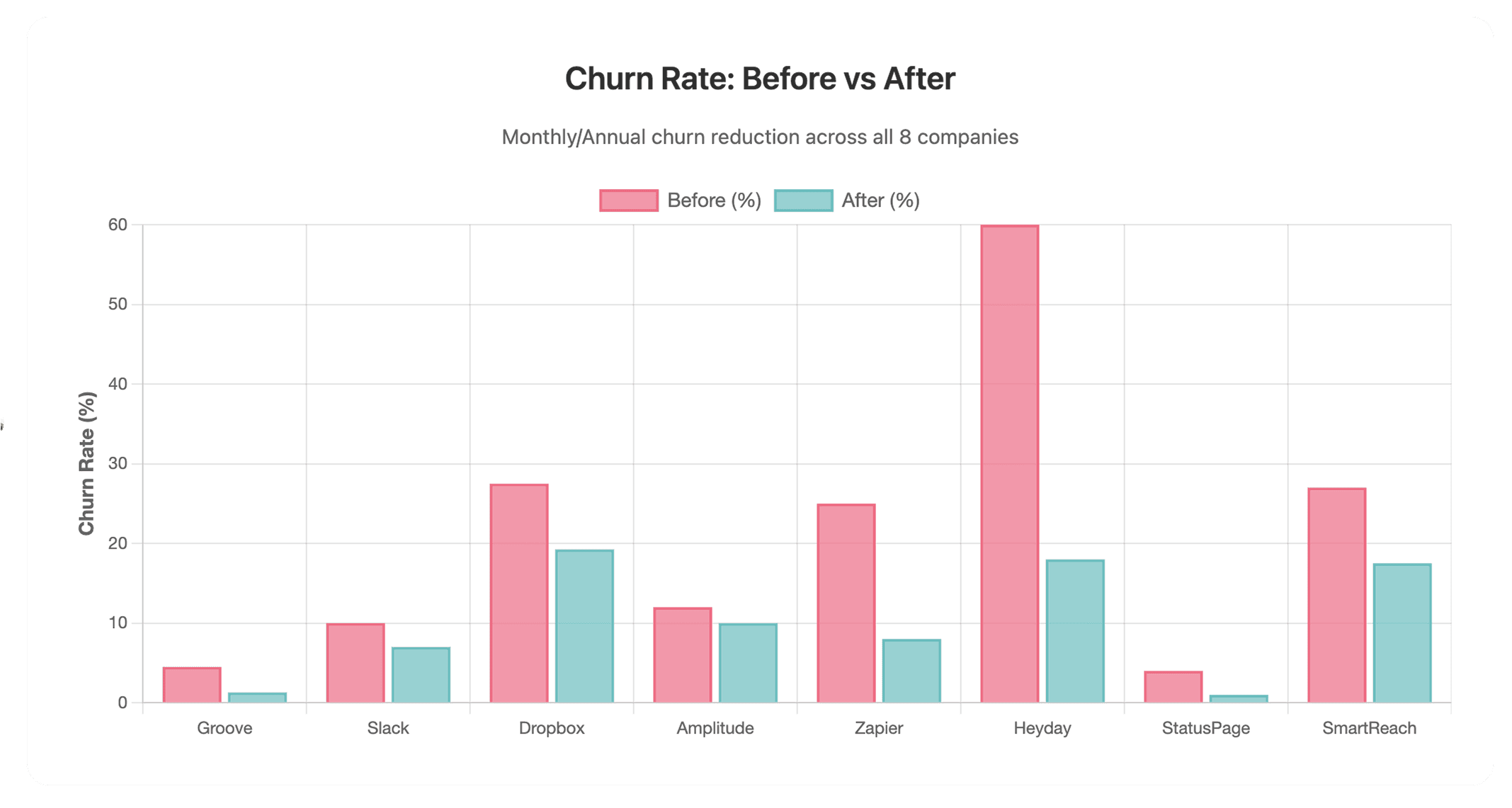
1. Groove: Building a Predictive Early Warning System
The Crisis
In early 2015, Groove's helpdesk platform was hemorrhaging customers at 4.5% per month. Compound that over a year, and you're replacing more than half your customer base annually.
Measurement Approach
Monthly churn formula: Cancellations ÷ total subscribers at month-start
Real-time tracking: Connected billing to CRM flags
Cohort retention analysis: Validated churn wasn't isolated to specific campaigns
Root Causes
Low Agent Engagement: Support teams rarely logged in—using it sporadically at best. Part of the issue stemmed from SaaS login screen UX issues that didn't encourage daily engagement.
Feature Blind Spots: Most customers had no idea about automation capabilities and reporting functionalities—the features that could transform their workflows.
Late Detection: By the time Groove noticed at-risk accounts, customers had been disengaged for weeks with minimal activity.
The Solution: Red Flag Metrics System
Behavioral KPIs as Predictive Signals: They identified three leading indicators—session duration, daily active agents, and ticket-resolution time.
Threshold-Based Automated Alerts: When session duration dropped below one minute or other thresholds were crossed, the system automatically triggered assistance emails within two hours.
Unified Data Pipeline: Built a consolidated dashboard pulling CRM, product analytics, and support logs for holistic visibility.
Results
Monthly churn dropped from 4.5% to 1.3% (71% reduction)
26% of flagged users opened assistance emails and took action
40% uplift in three-month renewal probability for intervention recipients
Key Lesson: Don't wait for customers to ask for help. Build systems that detect problems before customers realize they're struggling.
2. Slack: Turning Trials Into Collaborative Teams
The Crisis
8-10% of newly created workspaces failed to convert from trial to paid within 30 days.
Measurement Approach
30-Day Trial Churn: Percentage of trial workspaces that didn't upgrade by day 30
Event-based tracking: Daily calculation of conversion rates
Survival analysis: Identified when during the trial teams dropped off
Root Causes
Insufficient Network Effects: Many workspaces had only one or two members. With just two people, it's glorified direct messaging—the network effects that make Slack magical only kick in with critical mass.
Low Message Volume: Workspaces with fewer than 50 messages in the first two weeks often stalled permanently.
Underutilized Integrations: Teams rarely connected external apps, limiting Slack's utility as a workflow hub.
The Solution: Team-Based Predictive Analytics
Team Activity Mapping: Aggregated metrics at workspace level—member growth, message counts, integration installs.
Network Density Analysis: Measured how connected team members were—not just member counts, but actual collaboration patterns.
Machine Learning Models: Predicted which teams were unlikely to upgrade as early as day 3-5 of trial.
Targeted Automated Prompts: Deployed in-app nudges at precise moments. These best UX fixes for SaaS trial signup screen included:
Low member count: "Invite your teammates to get the most out of Slack"
No integrations: "Connect Google Drive to share files instantly"
Declining messages: Suggestions for creating topic-specific channels
Results
30% reduction in trial churn (10% to 7%)
At-risk teams identified 2-3 weeks earlier
Conversion rates rose dramatically when teams added 3+ members in the first week
Key Lesson: For collaboration tools, individual behavior doesn't matter much. Team behavior is everything.
3. Dropbox: Training Your Way Out of Churn
The Crisis
25-30% churn across free and paid tiers, with business customers barely using the features they paid for.
Measurement Approach
Free-Tier Churn: Percentage of accounts with zero syncs over 30 days
Paid-Tier Churn: Quarterly cancellations ÷ paid subscriber base at quarter-start
Integrated data: Combined billing, installation logs, and sync events
Root Causes
Underutilization: Business customers weren't touching team folders, admin consoles, or version history—essentially using Dropbox Business like expensive Dropbox Basic.
Insufficient Admin Onboarding: Administrators lacked training on permissions, shared folders, and team structures, creating organizational friction.
Feature Unawareness: Users discovered new features months after release, if at all.
The Solution: Training-Driven Retention
Role-Based Programs: Created targeted curricula for three user types:
Administrators: Permissions, provisioning, security settings
Power Users: Selective sync, version control, advanced sharing
End Users: Basic operations and collaboration
Multi-Language Localizations: Delivered content in six languages with regional business practices.
Proactive Education: Launched webinars and tutorials immediately around feature releases.
Engagement Tracking: Measured video completion, tutorial clicks, and documentation visits to refine content.
Results
30% increase in advanced feature adoption
Significant business-tier churn decrease
Major lift in multi-year contract renewals
15% CSAT improvement in post-training surveys
Key Lesson: Sometimes churn isn't about your product—it's about whether customers know how to use it.
4. Amplitude: Product-Led Growth as Retention Strategy
The Crisis
12% annual churn among free users who never generated actionable reports—sitting in limbo, occasionally logging in but never really using the product.
Measurement Approach
180-Day Free Churn: Accounts with no logins or reports for six consecutive months
Combined signals: Tracked both logins and report creation
Cohort analysis: Followed user journeys from signup through engagement
Root Causes
Interface Complexity: Free users saw dashboards full of unfamiliar terminology and felt overwhelmed without guided support.
Missed "Aha" Moments: Users never reached the thresholds where Amplitude's value clicked—first meaningful report, unexpected insight, regularly-checked dashboard.
Insufficient Upgrade Prompts: Not enough contextual demonstration of premium features.
The Solution: Product-Led Growth
Behavioral Cohort Segmentation: Grouped users by early actions—report creators, dashboard visitors, data importers, explorers. Each cohort got different treatment.
Freemium Funnel Optimization: Strategic feature caps (monthly event limits) with well-timed upgrade prompts: "You've reached your 10 million events. Upgrade to analyze unlimited data."
Self-Service Onboarding: Embedded interactive guides throughout the product. To optimize SaaS onboarding screen UX, they included:
Step-by-step wizards for first reports
Contextual help explaining metrics
Sample data sets for exploration
Templates for common use cases
Results
Noticeable increase in free-to-paid conversion for users creating 2+ reports in month one
Strong retention metrics contributed to successful 2021 IPO
Top-of-category retention rates for analytics platforms
Key Lesson: For complex products, build the learning journey into the product itself.
5. Zapier: Onboarding as Competitive Advantage
The Crisis
25% of new ActiveCampaign users stopped running automations within 90 days—creating Zaps but never getting sustained value.
Measurement Approach
90-Day Churn: Users with zero active Zaps during days 61-90
Run logs: Tracked whether Zaps actually ran, not just existed
Root Causes
Lack of Guided Onboarding: Users created simple Zaps but weren't shown advanced capabilities—multi-step workflows, filters, formatters, conditional logic.
Insufficient Value Demonstration: Early workflows were too simple to show Zapier's compounding value.
No Success Milestones: No clear markers to celebrate progress and encourage exploration.
The Solution: Onboarding-Driven Engagement
Contextual Webinar Auto-Enrollment: Triggered when users connected high-value apps—not generic training, but targeted to their specific integrations.
Segmented Email Drips: Use-case-specific sequences based on connected apps (Gmail+Calendar got scheduling workflows, Shopify+Slack got order notifications).
In-Product Contextual Modals: At friction points, suggested complementary Zaps. Just added contacts to ActiveCampaign? Here's a Zap to tag them by behavior.
Milestone-Based Outreach: Celebrated achievements at "First Zap," "Multi-Step Zap," and "Team Zap" with education about next levels.
Results
Churn fell from 25% to 6-10% over 90 days
440% increase in onboarding engagement
65% increase in multi-step Zap creation
Accelerated time-to-value
Key Lesson: Onboarding isn't a one-time event—it's a journey of progressive value realization.
6. Heyday: Engineering the Critical First Experience
The Crisis
Over 60% of new accounts failed to send a single AI response within seven days—never experiencing core product functionality.
Measurement Approach
7-Day Early Churn: Accounts with zero bot responses by day 7
Bot API logs: Tracked every interaction attempt, successful or failed
Root Causes
Onboarding Friction: Multiple complex steps—widget integration, fallback intents, AI training, testing. The confusing SaaS screen flow was causing users to abandon the setup process.
Delayed Value: Time from signup to first real conversation was too long, and these issues helped reduce user dropoff on SaaS setup screen became a primary focus.
Knowledge Gaps: Limited in-product guidance—users expected to figure things out from documentation.
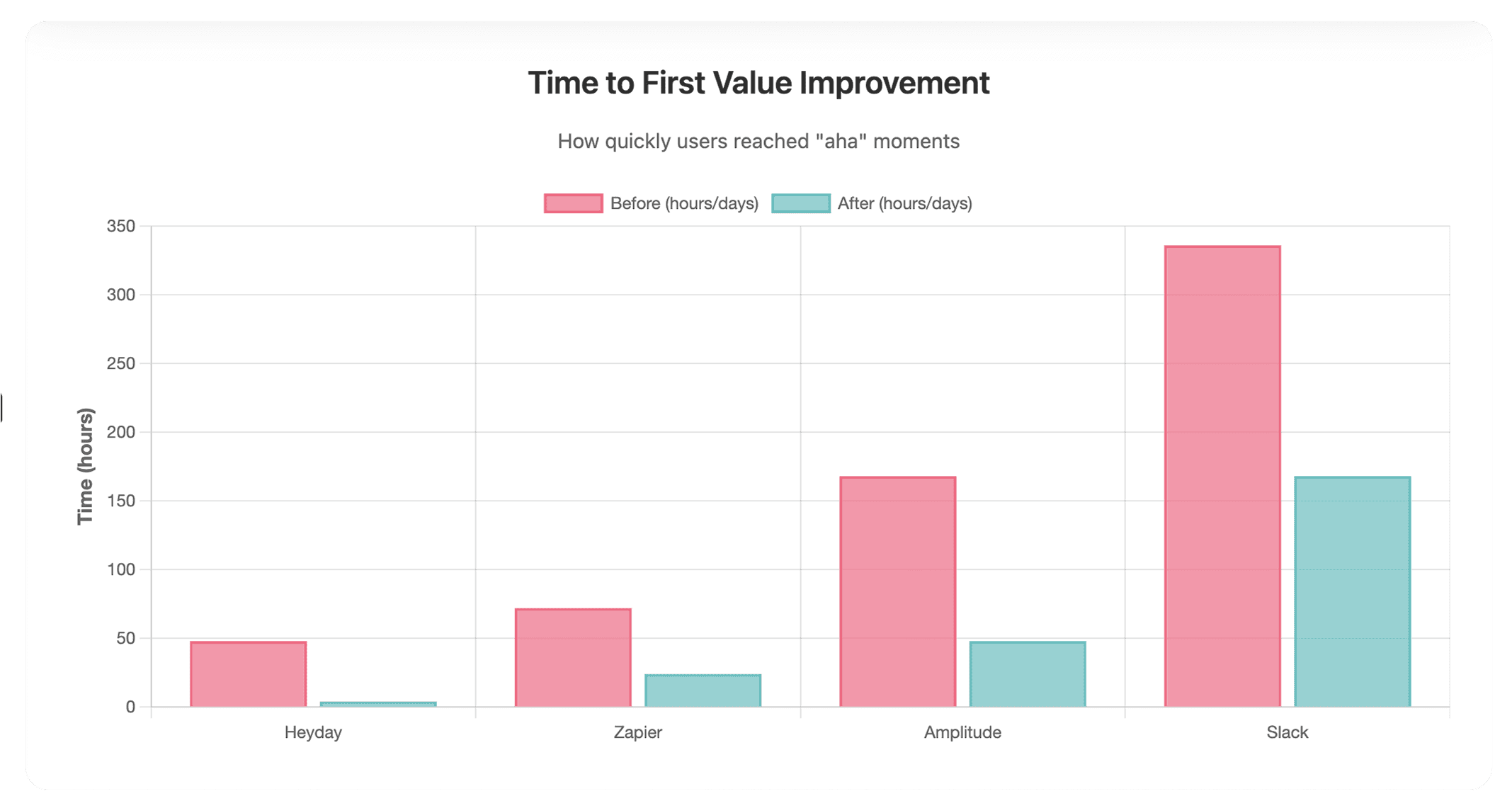
The Solution: "Aha" Moment Engineering
Three-Step Setup Wizard: Streamlined process reducing decisions at each step:
Widget integration—drag and drop or simple code snippet
Sample response review—see bot's common responses
Test message—send and see bot respond in real-time
Contextual Tooltips with Micro-Interactions: Step-specific help bubbles with subtle animations. These micro-interactions on SaaS screen design explained what each field does, why it matters, and good examples.
Embedded Video Tutorials: 30-90 second videos accessible inline—no external documentation needed.
Real-Time Success Celebrations: Prominent success message when bot sent first response: "Your bot just helped its first customer!"
Results
Early churn dropped by 300%
Over 75% of accounts achieved at least one bot response (from under 40%)
Time to first response fell from 48 hours to under 4 hours
Key Lesson: Your product's first experience is everything. If users can't get value quickly, they won't stick around.
7. StatusPage.io: Saving Customers Before They're Gone
The Crisis
4% monthly churn in at-risk cohorts (≈20% of accounts) threatened significant annual recurring revenue.
Measurement Approach
Monthly Churn: Downgrades/cancellations ÷ active accounts at month-start
Nightly tracking: Billing events and plan-change analysis every night
At-risk identification: Tracked accounts showing early warning signs
Root Causes
Usage Declines: Reduced status updates, declining dashboard access, fewer team logins, less incident creation—all signaling waning interest.
Generic Outreach Failures: One-size-fits-all emails fell flat. Different usage patterns needed different messages.
Manual Detection Delays: Customer success noticed declines weeks after they began.
The Solution: Cohort-Based Re-Engagement
Behavioral Cohort Creation: Segmented into specific groups—Monthly Reporters, Incident Creators, Scheduled Maintenance Users, Dormant Dashboards.
Automated Drop-Off Alerts: Nightly analysis flagged accounts with ≥30% weekly usage drop versus historical average.
Tailored Campaigns: Different interventions by cohort—in-app notifications, targeted emails, opt-in SMS for high-ARR accounts. Messaging was specific: "We noticed you haven't published an incident update in 3 weeks..."
CSM Integration: Slack alerts to customer success with context (customer name, ARR, usage decline pattern, talking points) when automation wasn't working.
Results
Churn in at-risk cohorts fell from 4% to 1% monthly (75% improvement)
$1.2 million in ARR preserved
Problems caught 3-4 weeks earlier than manual monitoring
Key Lesson: Churn prevention is about catching small problems before they become big ones.
8. SmartReach.io: Leadership-Driven Health Monitoring
The Crisis
27% annual churn as users abandoned email outreach sequences more than a quarter of customers leaving each year.
Measurement Approach
Annual Churn: Cancellations over year ÷ accounts at year-start
Real-time tracking: Billing and account-status API monitoring
Root Causes
Delivery Failures: Poor email deliverability—messages landing in spam or blocked. Users blamed the tool, not their practices.
Lack of Campaign Insights: No easy way to gauge effectiveness mid-campaign. Users launched sequences and hoped, without real-time feedback.
Sequence Abandonment: Complex setup plus uncertain results discouraged continued use.
The Solution: Leadership-Driven Health Scoring
Composite Health Score: Single KPI merging deliverability rate, reply rate, and sequence completion. Different issues needed different solutions.
Executive-Level Alerts: Low scores triggered leadership and CS attention for VIP accounts ensuring high-value relationships got immediate intervention.
Real-Time Insights Dashboard: Live campaign performance showing deliverability trends, reply rates, best subject lines, optimal send times, and automated recommendations. Knowing how to improve SaaS dashboard UX for conversions, users could see what worked in real-time and adjust.
Proactive Recommendations Engine: Data-driven suggestions based on successful campaign patterns—"Your subject lines average 8 words. Try 4-6 words to improve open rates."
Results
Annual churn dropped from 27% to 17.5% (35% reduction)
22% increase in campaign success rates among high-priority accounts
Issues caught and addressed 2 weeks earlier
Key Lesson: For B2B SaaS at higher price points, automated alerts combined with executive attention can save high-value relationships.
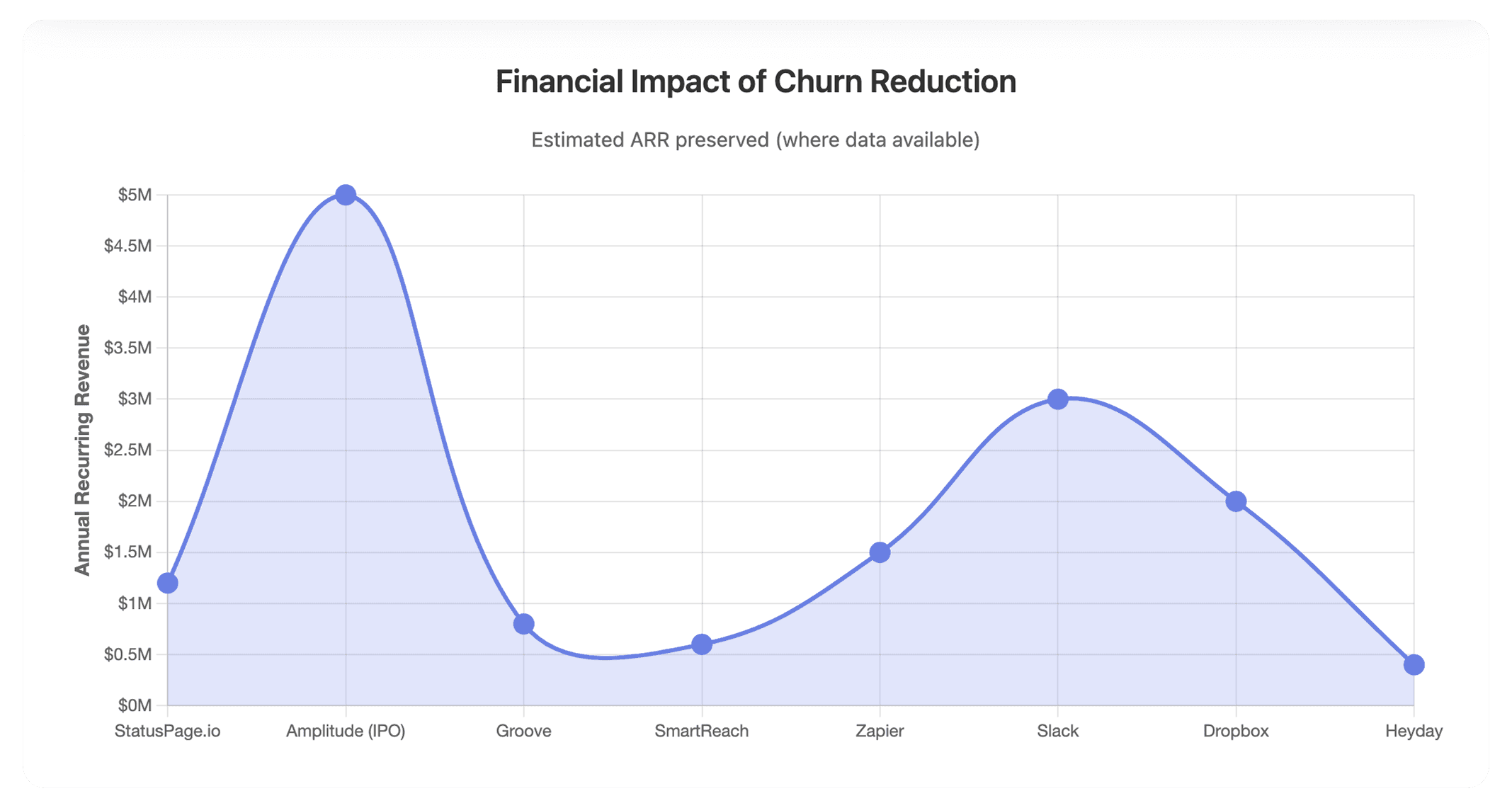
The Common Threads: What We've Learned
Looking across all eight companies, we've identified several patterns that any SaaS business can learn from:
1. Measure Behavior, Not Just Outcomes
Every single company we studied went beyond simple cancellation tracking. They measured session duration, feature adoption, engagement velocity, team dynamics, and leading indicators that predicted churn weeks in advance.
The companies that won weren't just asking "who churned?" They were asking "what behaviors predict churn before it happens?" This is the mindset shift we need to make.
2. Automate Early, Intervene Fast
Manual customer success can't scale, and by the time humans notice a problem, it's often too late. What we've seen is that the most successful companies built automated systems that monitored health continuously, triggered interventions within hours, deployed targeted messages, and only escalated to humans when automation wasn't working.
3. Onboarding Is the Make-or-Break Moment
Heyday, Zapier, and Amplitude all focused intensely on the first-user experience. What we've learned is clear: if customers don't reach their "aha" moment quickly, they churn. Applying SaaS screen UX tips for revenue growth during the onboarding phase directly impacts retention and conversion rates.
4. Segmentation Beats Generic Messaging
StatusPage.io's cohort-based campaigns, Slack's team-level analysis, and Dropbox's role-based training all worked because they recognized different customers have different needs. One-size-fits-all is one-size-fits-none.
5. The First 30-90 Days Are Critical
Most churn decisions aren't made at renewal time—they're made in the first few months, as we've seen across multiple case studies. Early engagement determines long-term retention.
6. Combine Product Changes with Education
It's not enough to just build features—you need to teach people how to use them. Dropbox's training programs and Amplitude's in-product guides show us that sometimes churn isn't about your product quality; it's about customer education.
7. Make Data Accessible Across Teams
Groove's unified dashboard, SmartReach.io's executive alerts, and StatusPage.io's CSM integrations all ensured that the right people had the right information at the right time. What we've found is that retention can't live in a silo—it requires cross-functional collaboration.
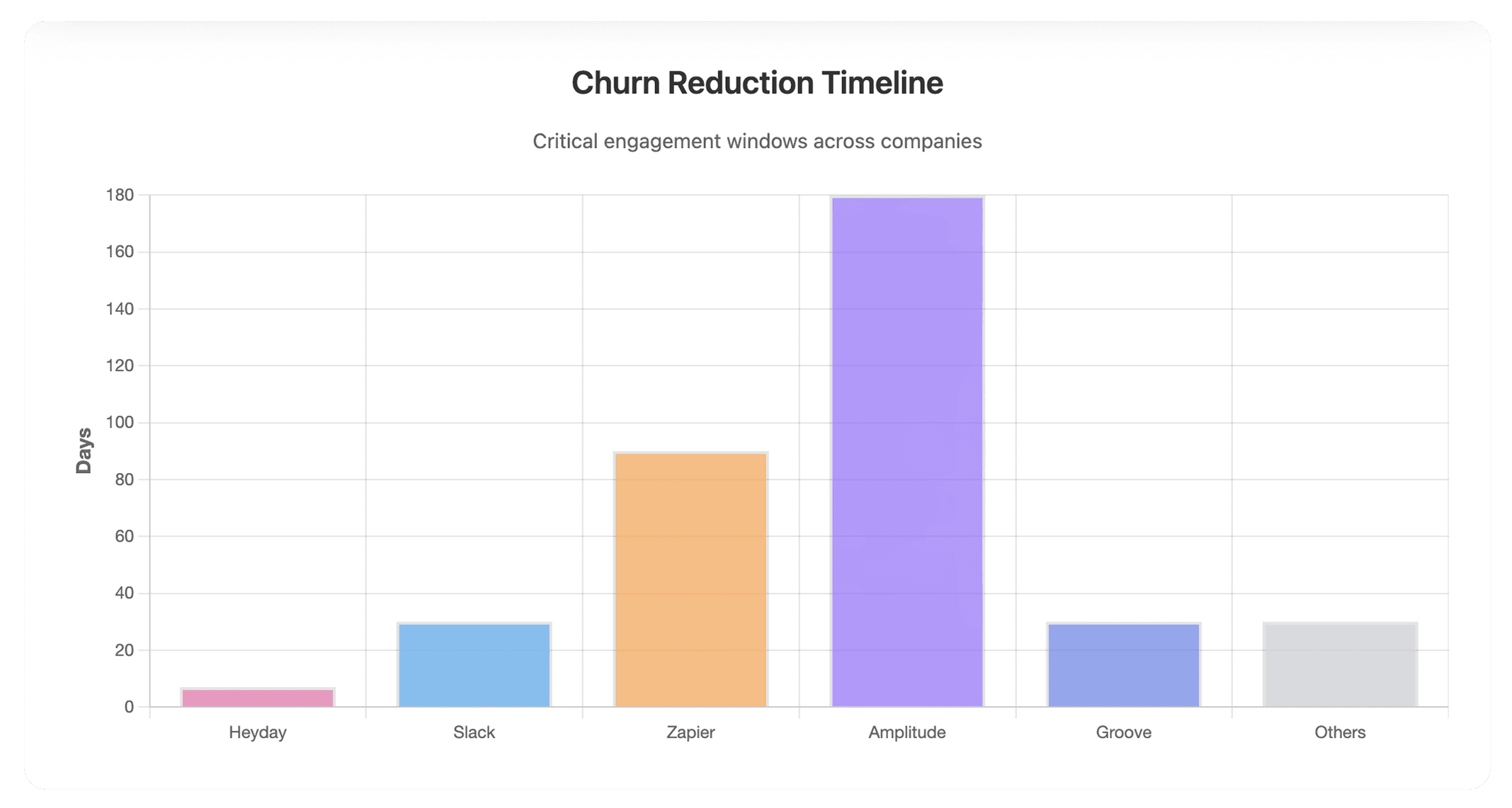
Your Churn Reduction Playbook
If you're facing churn challenges, here's how we recommend applying these lessons:
Step 1: Define Your Churn Metrics Precisely Don't just track cancellations—understand when and why customers leave. Set up cohort analysis and track leading indicators.
Step 2: Diagnose Root Causes Ruthlessly Interview churned customers, analyze behavioral patterns of at-risk versus healthy accounts, and identify your product's "aha" moments.
Step 3: Build Automated Detection Systems Create health scores based on leading indicators, set threshold-based alerts, and ensure systems can act in hours.
Step 4: Develop Targeted Interventions Segment customers by behavior, create specific messaging for different stages and segments, and test what drives re-engagement.
Step 5: Optimize Your First 30 Days Map your ideal customer journey, identify and eliminate friction points, build progressive engagement, and focus on ways to improve SaaS screen layout to reduce churn by simplifying navigation and clarifying user paths.
Step 6: Measure, Learn, and Iterate Track intervention effectiveness, A/B test different approaches, and continuously refine your health score calculations.
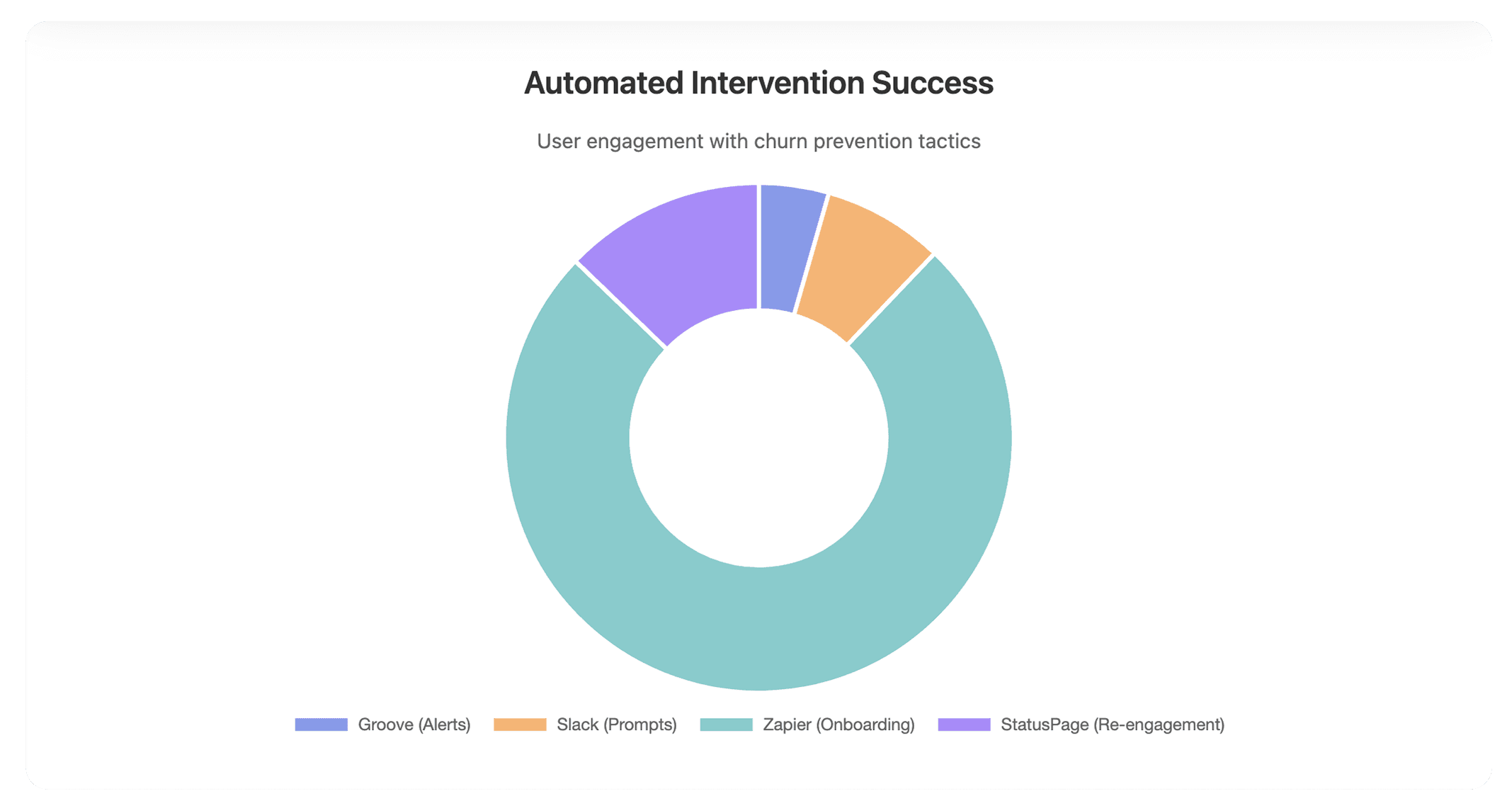
The companies we've profiled reduced churn by 30-75% not through magic, but through systematic problem-solving: precise measurement, diagnostic rigor, thoughtful strategy, and relentless execution.
What we've learned from studying these eight companies is clear: churn isn't inevitable. With the right approach, you can turn your leaky bucket into a retention machine.








